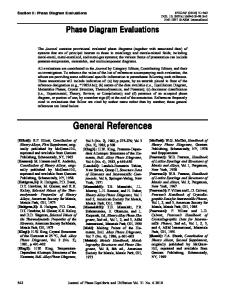Low-temperature extension of the lehrer diagram and the iron-nitrogen phase diagram
- PDF / 191,630 Bytes
- 6 Pages / 612 x 792 pts (letter) Page_size
- 63 Downloads / 321 Views
ron-nitrogen phase diagram has been studied extensively in the past. A detailed knowledge of this system is of great importance, since the presence of nitrogen in iron or steel can improve the mechanical and chemical properties of these materials and gives rise to interesting magnetic properties.[1,2,3] At the start of our investigation, the Fe-N phase diagram was only known for temperatures above 300 ⬚C.[4] In an earlier report,[5] we have already extended the phase diagram in a downward direction, based on measurements in the temperature interval 275 ⬚C to 350 ⬚C. The purpose of this investigation is a further extension of this phase diagram to lower temperatures. Very recently, Malinov et al.[6] published data that are relevant for the low-temperature part of the phase diagram down to 100 ⬚C. The most stable iron nitride phases at lower temperatures are ␣ -FexN (x ⬎ 250), which is a solid solution of nitrogen atoms in bcc iron; ␥ ⬘-Fe4N, with an ordered sublattice of N in fcc iron; ⑀ -FexN (2 ⬍ x ⬍ 3), in which the iron atoms form a hexagonal lattice; and orthorhombic (or )-Fe2N. In principle, these nitrides can be formed in a reaction between nitrogen gas and iron, but the equilibrium gas pressures are very high: for ␥ ⬘-Fe4N at 200 ⬚C the equilibrium pressure of the nitrogen is 1500 bar.[7] So ␥ ⬘-Fe4N is unstable at normal, atmospheric pressures, but a high kinetic barrier in the N ⫹ N → N2 reaction prevents its decomposition at temperatures below 400 ⬚C. The same is true for ␣ -FexN, ⑀ -FexN, and -Fe2N. Less stable iron nitrides are ␣ ⬘-FexN, which is an over-saturated solid solution of nitrogen in ␣ iron, in which the bcc lattice is deformed into a bct structure and ␣ ⬙-Fe16N2, in which the nitrogen atoms have an ordered structure. In this phase part of the iron atoms have an extraordinary large magnetic moment.[8] The ␣ ⬙ phase becomes unstable with respect to ␣ -FexN and ␥ ⬘-Fe4N in the temperature region 160 to 220 ⬚C.[9,10] Growth of the ␣ ⬙ phase was observed after nitriding epitaxial iron layers at a temperature E.H. DU MARCHIE VAN VOORTHUYSEN, Assistant Professor, and D.O. BOERMA, Professor, are with the Research Group Nuclear Solid State Physics, Materials Science Center MSC, University of Groningen, NL 9747 AG Groningen, The Netherlands. Contact e-mail: voorthuysen@ phys.rug.nl N.C. CHECHENIN, Leading Scientist, Research Group Nuclear Solid State Physics, Materials Science Center MSC, University of Groningen, is also with the Institute of Nuclear Physics, Moscow State University, Moscow, Russia. Contact e-mail: [email protected] Manuscript submitted June 15, 2001. METALLURGICAL AND MATERIALS TRANSACTIONS A
of 200 ⬚C in pure ammonia.[11] An overview of iron nitride phases has been given by Schaaf et al.[12] The most convenient way to produce iron nitrides is by exposure of iron metal to a mixture of NH3 and H2. Depending on the temperature and the chemical potential N of nitrogen atoms in the mixture of NH3 and H2
N ⫽ G⬚NH3 ⫺ G⬚H2 ⫹ RT ln (rN) with (rN) ⫽
pNH3 pH3/22
[1]
a certain ph
Data Loading...











